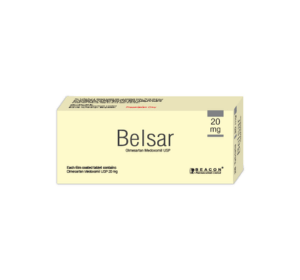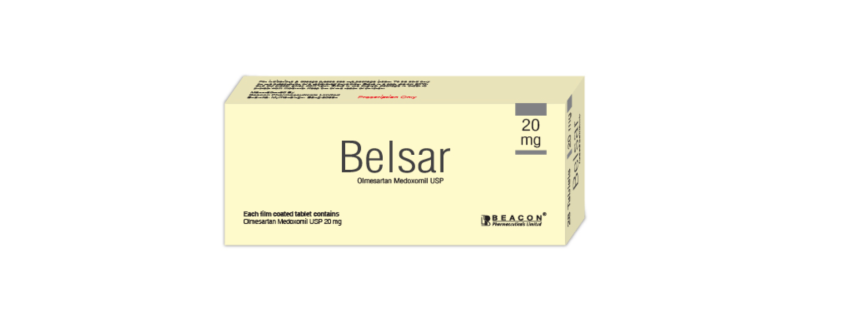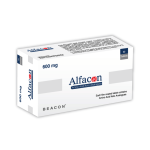Belsar

Generic Name:Olmesartan
Therapeutic Class:Angiotensin Receptor Blocker
Formulation : Tablet
Available Pack Size : Available Pack Size 4×7
Available Strength : 10 mg, 20 mg, 40 mg
Indications
Belsar is indicated for the treatment of hypertension. It may be used alone or in combination with other antihypertensive agents.
Pharmacology
Angiotensin II is formed from angiotensin I in a reaction catalyzed by angiotensin converting enzyme (ACE, Kininase II). Angiotensin II is the principal pressor agent of the renin-angiotensin system, with effects that include vasoconstriction, stimulation of synthesis and release of aldosterone, cardiac stimulation and renal reabsorption of sodium. Olmesartan blocks the vasoconstrictor effects of angiotensin II by selectively blocking the binding of angiotensin II to the AT 1 receptor in vascular smooth muscle. An AT 2 receptor is found also in many tissues, but this receptor is not known to be associated with cardiovascular homeostasis. Olmesartan has more than a 12,500-fold greater affinity for the AT 1 receptor than for the AT 2 receptor. Olmesartan medoxomil does not inhibit ACE (kininase II), it does not affect the response to bradykinin. Blockade of the angiotensin II receptor inhibits the negative regulatory feedback of angiotensin II on renin secretion, but the resulting increased plasma renin activity and circulating angiotensin II levels do not overcome the effect of olmesartan on blood pressure.
Dosage & Administration
Dosage must be individualized. The usual recommended starting dose of Olmesartan is 20 mg once daily when used as monotherapy in patients who are not volume-contracted. For patients requiring further reduction in blood pressure after 2 weeks of therapy, the dose of Olmesartan may be increased to 40 mg. Doses above 40 mg do not appear to have a greater effect. Twice-daily dosing offers no advantage over the same total dose given once daily.
No initial dosage adjustment is recommended for elderly patients, for patients with moderate to marked renal impairment (creatinine clearance <40 ml/min) or with moderate to marked hepatic dysfunction. For patients with possible depletion of intravascular volume (e.g. patients treated with diuretics, particularly those with impaired renal function), Olmesartan should be initiated under close medical supervision and consideration should be given to use of a lower starting dose. Olmesartan may be administered with or without food.
Paediatric use: Safety and effectiveness in paediatric patients have not been established.
Interaction
No significant drug interactions were reported in studies in which Belsar was co-administered with digoxin or warfarin in healthy volunteers. The bioavailability of olmesartan was not significantly altered by the co-administration of antacids. Belsar is not metabolized by the cytochrome P450 system and has no effects on P450 enzymes; thus, interactions with drugs that inhibit, induce, or are metabolized by those enzymes are not expected. Non-Steroidal Anti-Inflammatory Drugs (NSAIDs) including selective Cyclooxygenase-2 Inhibitors (COX-2 Inhibitors) in patients who are elderly, volume-depleted (including those on diuretic therapy), or with compromised renal function, co-administration of NSAIDs, including selective COX-2 inhibitors, with angiotensin II receptor antagonists, including Belsar, may result in deterioration of renal function, including possible acute renal failure. These effects are usually reversible. Monitor renal function periodically in patients receiving Belsar and NSAID therapy. The antihypertensive effect of angiotensin II receptor antagonists, including Belsar may be attenuated by NSAIDs including selective COX-2 inhibitors.
Contraindications
Olmesartan is contraindicated in patients who are hypersensitive to any component of this product.
Side Effects
Belsar has been evaluated for safety in more than 3825 patients/subjects, including more than 3275 patients treated for hypertension in controlled trials. Treatment with Belsar was well tolerated, with an incidence of adverse reactions similar to placebo. The overall frequency of adverse reactions was not dose related. Analysis of gender, age and race groups demonstrated no differences between Belsar and placebo treated patients. The rate of withdrawals due to adverse reactions in all trials of hypertensive patients was 2.4% of patients treated with Belsar and 2.7% of control patients. In placebo controlled trials, the only adverse reaction that occurred in more than 1% of patients treated with Belsar and at a higher incidence versus placebo was dizziness (3% vs. 1%)
The following adverse reactions occurred in placebo-controlled clinical trials at an incidence of more than 1% of patients treated with Belsar, but also occurred at about the same or greater incidence in patients receiving placebo: back pain, bronchitis, creatine phosphokinase increased, diarrhea, headache, hematuria, hyperglycemia, hypertriglyceridemia, influenza-like symptoms, pharyngitis, rhinitis and sinusitis. The incidence of cough was similar in placebo (0.7%) and Belsar (0.9%) patients.
Pregnancy & Lactation
When pregnancy is detected, discontinue this product as soon as possible. When used in pregnancy during the second and third trimesters, drugs that act directly on the renin-angiotensin system can cause injury and even death to the developing fetus. It is not known whether Olmesartan is excreted in human milk, but Olmesartan is secreted at low concentration in the milk of lactating rats. Because of the potential for adverse effects on the nursing infant, a decision should be made whether to discontinue nursing or discontinue the drug, taking into account the importance of the drug to the mother.



